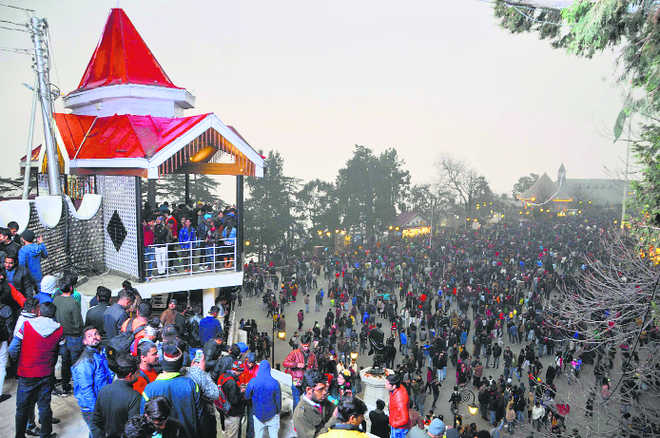Massive problems with mass tourism
Avay Shukla
The world is gradually discovering that tourism can be a double-edged sword in that though it brings in revenue and employment, it has a grave social, cultural and environmental impact. This is becoming more and more evident in Himachal. As many as 17.5 million tourists visited the state in 2015 (2.5 times its population!) and the number is growing at 7.5 per cent per annum, thanks partly to the unsettled conditions in Kashmir. It generates Rs 1,200 crore, about 10 per cent of the state’s GDP. It also creates 400,000 jobs.
But the downside can no longer be ignored. Tourism in Himachal is primarily mass tourism, not the quality variety. This is evident from a McKinsey report of 2015 which found that the average per tourist spending was only Rs 600, and that 96 per cent of the tourists were in the income bracket of Rs 1 to Rs 5 lakh per annum. Secondly, almost 50 per cent of the visitors were concentrated in just three destinations: Kullu (33.15 lakh), Shimla (32.65 lakh) and Kangra (24 lakh). The combined effect of these numbers is devastating the natural environment and leading to massive, unplanned urbanisation, which has turned all the state’s towns into virtual slums. The mushrooming of sub-standard hotels, resorts, dhabas is like a cancerous scab on the beautiful mountain landscape, which has now spread even to the rural areas. Rivers are being choked by garbage and plastics, trees being felled in thousands, roads are crowded with vehicles headed nowhere, water shortages are common in a state which has a thousand streams. The infrastructure of the state is collapsing under the sheer weight of numbers. Any honest and multi-sectoral cost-benefit analysis would reveal that tourism in Himachal is a losing proposition and needs a rethink at the policy level.
The state government has to become proactive in shaping the type of tourism and nudging it towards greater quality, rather than being satisfied with the rising numbers every year which actually portend disaster. Equally important, it has to aggressively protect and preserve its natural features, for without them there would be no tourism at all. It should consider the following initiatives:
- Stop registration of new hotels or other hospitality units in the towns, which have already exceeded their carrying capacity long ago, such as Shimla (including Mashobra), Manali, Kullu, Dharamsala, Solan, Palampur and Dalhousie. This will not only discourage the insane construction activities in these degraded urban areas but will also help to disperse the crowds to other under-fed areas of the state.
- Connectivity has to be improved: High-end tourists will not spend five hours travelling from Chandigarh to Shimla, and the flights to Dharamsala, Manali and Shimla are irregular and exorbitantly priced. The state should invest in helicopter services, with Shimla as the hub. A proposal was floated in 2008 but has got nowhere, primarily because Shimla lacks a civilian helipad. Efforts by the government to persuade Rashtrapati Bhavan to allow the use of the Kalyani helipad near Charabra were rebuffed by the President’s office on “security” grounds, even though it is not used 364 days in a year! I believe another site has been identified near Dhalli, but the proposal continues to languish in some file.
- Revive the ambitious Ski Village proposal — a Rs 1,200-crore FDI project — which would have firmly brought Himachal onto the international map — which was shot down by the Dhumal government under the vested pressure of hoteliers in the Manali area.
- Promote, and concentrate on, nature and adventure tourism rather than simply the “chhola bhatura” kind of commerce that passes for tourism today. With 32 wild life sanctuaries, four unique national parks, more than 400 forest rest houses, the state has unmatched potential for trekking, rafting, bird-watching, mountaineering and allied sports which unfortunately is not being exploited. A reluctant Forest Department has been gradually nudged into sharing these assets by the formation of an Eco-Tourism Society some years ago, but it has to do much more. It is imperative, however, to fix the carrying capacity of each unit and strictly regulate numbers. Eco-tourism and home stays are the way forward.
- The government should stop destroying the natural environment by building more and more roads into pristine areas just so that ever increasing numbers of cars filled with people who have no concept or genuine love of nature can despoil these areas and leave their fast food garbage behind. It should not make it easier for such elements to access our natural treasures. If required, install ropeways only. It is disheartening to note that even though the three ropeways to Rohtang, Bijli Mahadev and Triund were approved almost 10 years back, they are nowhere near completion. Think of more ropeways, like one from Dhalli to Kufri, or Dalhousie to Khajjiar, both destinations swamped by vehicles in the season; the former is additionally buried under mule dung!
- Himachal needs a total paradigm shift in the way it thinks tourism and it must learn from international experiences. Tourism has become one of the biggest threats to nature and local cultures worldwide. On any given day, there are 3 million tourists tramping all over the world and the figure will go up to 6 million by 2025; that is 1.8 billion tourists on the loose! If not regulated or channelised properly and in time, they will be like a swarm of locusts, destroying everything worth conserving. Local populations have started reacting with hostility to tourists -- in Venice, Barcelona, Thailand, Nepal, Bhutan. I am positive the permanent residents of Shimla feel the same way. They need to speak up while there is still some standing room on The Ridge.
(The writer is a retired IAS officer)









